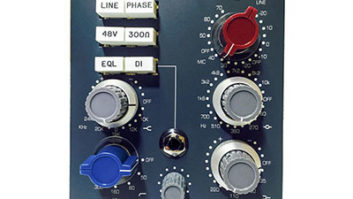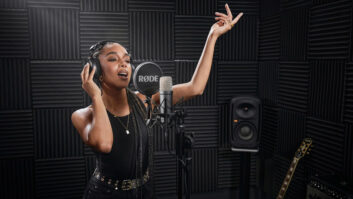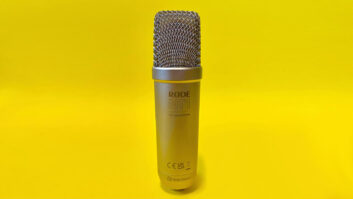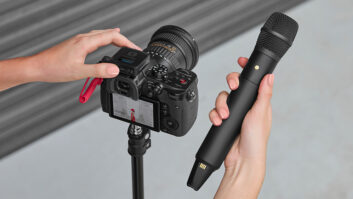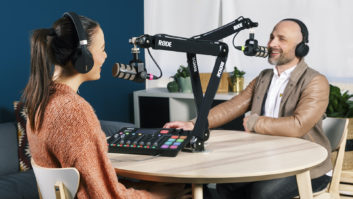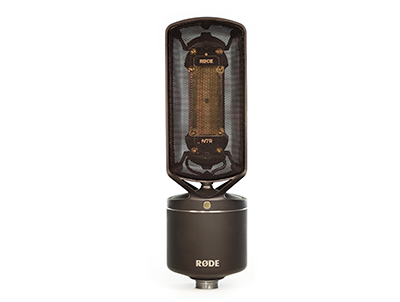
Made entirely at an in-house manufacturing plant in Sydney Australia, RØDE’s NTR is the company’s first ribbon microphone. The NTR is a large microphone; it’s 216 mm tall, 65 mm wide, and weighs over a kilogram with the internal transformer, base assembly and XLR connector contributing to its heft.
It is an active mic with a 1.8-micron ribbon and features an internal shock-mounted motor assembly, obviating the need for an external shock-mount. When the mic is not in use or being moved, the shock-mount and ribbon motor are locked down securely using an included “travel” screw. The NTR’s internal aluminum casting contains a large step-up transformer and FET-based buffer amplifier. The transformer develops most of the voltage gain, with the amplifier providing the low-impedance (200-ohm) XLR balanced output. The NTR draws 4.5mA of 48-volt phantom power, has a maximum output level of 8 dBu, handles up to 130 dB SPL; noise measures 15 dBA.
In Studios
Setting up the NTR is no different than with any large studio microphone. It comes with the RM2 swivel-type mount that threads into the base cover. I found the mount to somewhat limit precise positioning of the mic. The mount’s knob for tightening down the swivel is a bit large, and although it makes it easier to use, I couldn’t always plug in an XLR cable once I had the mic in a desired location.
My first use was a pair of NTRs as drum overheads. The drummer’s kit was set up to project lengthwise down Musicians Institute’s Studio A. Ceiling height was 12 feet, and I had the NTRs spaced three feet apart over the drummer’s head and about three feet above the kit. I used standard-size stands and booms for this close setup, but if you want them higher up in the air, you’ll need larger boom stands. The studio’s SSL Duality mic preamps were set at minimum gain with no attenuation pad or highpass filter required.
Listening to only the two NTRs, the low frequencies of the kick, toms and snare were in good balance—relative to the cymbals—actually a better balance than when I stood out in front of the kit in the studio! Out there the drummer’s cymbals were loud and abrasive but (back in the control room) the NTR had them sounding smooth, not harsh. I could hear the sound of the room, as well as leakage from the adjacent guitar and bass amps.
I found that I could lessen the pickup of leakage and reflections from the left and right walls on either side of the drum kit by positioning the NTR’s side null points (perpendicular to the front and rear pattern lobes) so that they were aimed at the left and right walls. At the same time, the drum’s sound and room’s ambience and reflections were evident coming in the front and rear of the NTRs.
I was pleased with the NTRs as overheads; I got a great balanced coverage of the entire kit that mixed well with the presence provided by the close mics on the kick, snare and toms. I checked and found good mono compatibility when summing both overhead tracks to mono in the monitor mixer.
Back at my Tones 4 $ Studio, I got an excellent and immediate electric guitar sound using a single NTR placed as close as possible and aimed at the center of the dust cover of the 12-inch speaker in my Fender Blues Junior amp. By comparison, my usual dynamic microphone sounded nasally no matter where I placed it on the speaker. The NTR is placement-sensitive—it will let you know immediately when you’ve got it on the sweet spot or not.
I had no overloading issues using my PreSonus AudioBox iTwo USB interface, with any tone changes made on the amp clearly heard. I found no need to exaggerate the amp’s treble or bass tone controls to compensate. When centered on the dust cover, it reproduced the sound of the amp exactly as I heard in front of it—including the booming low end I had dialed in. This mic worked well to reproduce the thick low end of chunky, drop-tuned guitars; my monitor’s subwoofer got busy.
At LAFX Studios, I recorded a Yamaha C7 grand piano with two NTRs. I first tried placing the mics as if they were cardioids 24 inches apart—just in front of and directly aimed at the hammers—rock ’n’ roll-style. But the reflections off the inside of the piano’s lid coming into the back of the NTRs made for a “boxy” sound. Moving both mics out from under the lid and at the edge of piano’s curve and aiming back at the hammers produced a great big fat rich sound with solid lows and smooth highs.
I used the studio’s API console with the mic preamps set to minimum, no pad or EQ. With so much audio to work with, it would be easy to dial in any finished sound with EQ/compression right away or later during a mix. I had complete flexibility.
For fun, I tried the same setup but flipped the NTRs around with the rear of the mics aimed back at the hammers. Some ribbon mics have a brighter sound on the rear because of the way the ribbon is positioned within the magnet structure. However, not with the RØDE NTR; they sound the same.
For a lead vocal recording, my female singer’s voice and technique were pleasantly complemented using a single NTR. The singer’s voice tended toward a hard and harsh sound especially when singing loud. With a Pete’s Place Blast Filter (metal popscreen), the RØDE NTR smoothed out her edginess greatly. It was important to keep her aimed at the NTR to maintain a bright sound, and in that way when singing loud and hard, the NTR was brilliant yet full-sounding for her.
Extras
RØDE also offers the SMR shock-mount with Rycote Lyre suspension and integrated metal pop filter. Apart from a longer Stereo Bar (due for release soon) for mounting two NTRs side-by-side such as I used for pianos or for Blumlein pairs, RØDE has no plans for any future mount choices for this mic.
The company recommends removing the travel screw completely before use. I had no problems with it rattling by leaving it threaded in the top of the mic so it wouldn’t go missing. A threaded “blind hole” drilled somewhere on the mic’s body for interim storage might be a good update at some point.
The RØDE NTR active ribbon microphone comes in a black matte finish and has a one-year ribbon replacement guarantee during the warranty period. With online registration, there is also a 10-year extended warranty available. A local RØDE distributor would replace the entire ribbon motor assembly, and if outside of warranty, it will cost $120. Check the Website for a list of local distributors.
I tried the NTR on many different sources with great success on most. For any source with a percussive edge like drums, pianos, electric guitars or vocalists with their own edginess, the NTR is invaluable in obtaining a flattering and lovely sound instantly.
Barry Rudolph is an L.A.-based engineer and educator. You can visit his website at www.barryrudolph.com.
